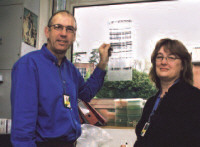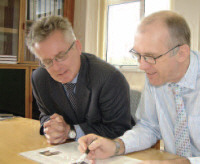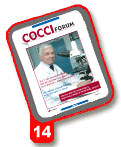Passing The So What Test
Genetic studies of Eimeria could lead to big breakthroughs in coccidiosis control
Professor Martin Shirley gets frustrated
at times. His research into
the genetics and genomes of
Eimeria could lead to major advances in
coccidiosis control. But to anyone outside
his field, Shirley's work seems
complicated, futuristic and, well "boring
to those involved with poultry production.
And talk of it often falls upon
deaf ears.
"This is not science fiction," Shirley
says. "I want producers and veterinarians
to understand that this research will
pass the 'so what' test. It has huge
potential significance for controlling
coccidiosis, which remains one of the
economically important diseases in
poultry."
Shirley is director of the Institute for
Animal Health (IAH), the largest
research institute focused on livestock
diseases in the United Kingdom. In the
1980s, he led the team that developed
the world's first attenuated coccidiosis
vaccine, which set the stage for what is
now known in Europe as the Paracox
line.
Today, his focus is nailing down the
genetics of E. tenella, the most widespread
and problematic of the Eimeria
species affecting poultry. Shirley initiated
the project and is working jointly
with Fiona Tomley, also of IAH, as well
as researchers at the Sanger Institute of
the UK, the Malaysia Genome Institute,
the University of Sao Paolo, Brazil and
the Laboratory for Molecular Biology of
the UK Medical Research Council.
Benefits for poultry producers
Studying the genetics of the ever-evolving Eimeria, Shirley predicts, will lead to simpler but more effective methods of protecting poultry from coccidiosis. It's the only way the poultry industry will be able to meet demand, perform up to par and reap better profits, Shirley says.

Consider that Eimeria has evolved
over tens of thousands of years. It has
become adept at subverting the biology
of its host "the chicken "to its own
advantage, and it's likely to keep evolving.
"We're trying to untangle that relationship
so we can intervene and come
up with new control measures as they
are needed. It's a tough challenge," he
says.
Toward that goal, the researchers
are 'mapping' E. tenella's genome.
Genome is another word for genetic
information. In short, Shirley and colleagues
are deciphering the parasite's
genetic makeup.
"When we started the work, the
genetic information of E. tenella was a
bit like having a book that has no chapters,
paragraphs, sentences or punctuation
and you have to figure out where
each strand of words belongs and fits
together," he says.
Until recently, virtually nothing was
known about the chromosomes of
Eimeria, Shirley says. Chromosomes are
the rod-shaped structures in the nucleus,
or center, of the cell and they carry
the genes which determine the characteristics
that an organism inherits from
its parents.
E. tenella has a sequence of 14 chromosomes.
"When we finish our mapping
project, we will have 14 sets of
information "one set of information
for each chromosome. But keep in
mind that these 14 chromosomes comprise
millions of pieces of data," Shirley
says.
Unique chromosomes

The project to map E. tenella's genetic
structure has already proved interesting
because the chromosomes of this
species are unique compared to most if
not all other organisms that have ever
been studied. In fact, they are among
the most complex organisms in all of
veterinary medicine, he says.
Shirley likens the study of E. tenella
chromosomes to discovering the patterns
along strings with four different
colored beads. "Imagine the 14 chromosomes
of E. tenella as 14 strings each
containing between 1 million and 14
million of the four differently colored
beads," he says.
Interestingly, a study of the smallest
chromosome has revealed that it contains
distinct, alternating regions.
Looking from left to right, the beads initially
appear as though the colors are
distributed randomly, then there are
distinct and repeating patterns of color,
then seemingly random colors again,
then the strong and repeating patterns
of color and, finally, seemingly random
colors again, Shirley says.
"Our mission is to identify similarities
in the patterns of these 'beads' and
then link them to specific traits that will
enhance our understanding of the parasite
and the best way to control it,"
Shirley says.
E. tenella's unique arrangement may
explain parasitic mysteries such as why
Eimeria has become increasingly resistant
to drugs. Chromosomes from two
Eimeria strains are known to come
together during sexual reproduction, he
says, but that is all the detail known at
present.
Although the genomic mapping of
E. tenella is an enormous undertaking,
the project is already about 95% complete,
Shirley says. Once done,
researchers can "data mine," producing
results that will be freely available
to anyone in the world who wants to
use the information for research or
development of commercially useful
products.
The IAH researchers want to discover
what it is about the Eimeria parasite
that causes chickens to develop a protective
immune response. They are also
looking at a technology known as
"transfection," which enables pieces of
DNA to be moved from one parasite
into another. The technology might
make it possible to develop a "piggyback" vaccine with one parasite that
would protect against all species of
Eimeria.
Flashback
Anyone who questions whether genetic
studies of Eimeria are too futuristic to
lead to something practical need only
consider the situation years ago when
scientists first grew Eimeria parasites in
chicken embryos.
At the time, scientists were viewed
with skepticism as they tried to discover
whether the life cycle of the parasite
could be modified, but they found the
answer was "yes." Moreover, the parasites
defined by the life cycle changes
were attenuated and could be used as
live vaccines." Soon after, the research
spawned other, better, approaches to
attenuation, which led to the development
of the breakthrough coccidiosis
vaccine 'Paracox', Shirley says.
"When we started collecting precocious
Eimeria parasites over 20 years
ago, we had no idea they were going to
become the sort of global standard for
control of coccidiosis with a live attenuated
vaccine. No idea at all," he says.
"Today, there are a billion doses a year
of the vaccine helping poultry producers
control coccidiosis in their flocks."
Vaccines are the future
Even though the coccidiosis vaccines of
today work well, making them requires
growing all the different species of
Eimeria that cause coccidiosis and then
harvesting them from chicken fecal
matter to make the vaccines. Birds
probably are receiving many more gene
products than they need.
In the future, it eventually may be
possible and more cost effective to
identify exactly which gene products
are relevant to immunity, then manufacture
"perhaps with genetic engineering
"single parasite vaccines that
protect against all types of Emeria.
New technology for controlling coccidiosis
that arises from the genomic
data, Shirley says, is likely to be a vaccine
because the continuing use of
chemotherapy is under political and
other pressures.
"The industry is embracing vaccines
and beginning to see that the future of
coccidiosis control will depend on vaccines.
We're already facing the prospect
in the European Union that drugs may
be removed entirely from system
because of consumer concerns. We are
then left with vaccines and, I believe, as
long as there is poultry, there will be a
need for Eimeria vaccines. That much is
very clear now," he says.
"For poultry to remain the major
meat-producing animal in many parts
of the world and remain of importance
to the UK, the United States and other
countries, there will have to be products
that effectively control coccidiosis.
And these products will not be developed
in 5 minutes by somebody having
a 'eureka' moment. They will come
from sophisticated scientific projects
such as genome analyses and genomic
mapping," he says.
For now, Shirley hopes that the
poultry industry will take note of E.
tenella genetic research, think about its
positive implications for the future and
meet the researchers with open ears.
"Be prepared to support our work,
which the industry will need," he says.
"It may not be for the people farming
now, but for their sons and daughters
and grandsons and granddaughters."
In turn, researchers have to do their
bit, he freely admits, by communicating
to the industry in understandable language.
"We can be accused of not
expressing ourselves in ways that can
be properly understood," he concedes.
"I hope the industry is ready to listen
and that it challenges us. We both need
to meet halfway. There's work to be
done."
Source: Cocciforum issue 14







